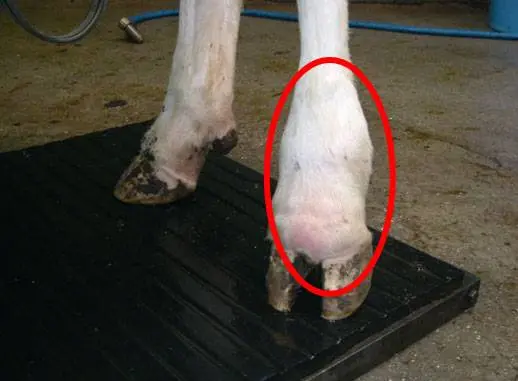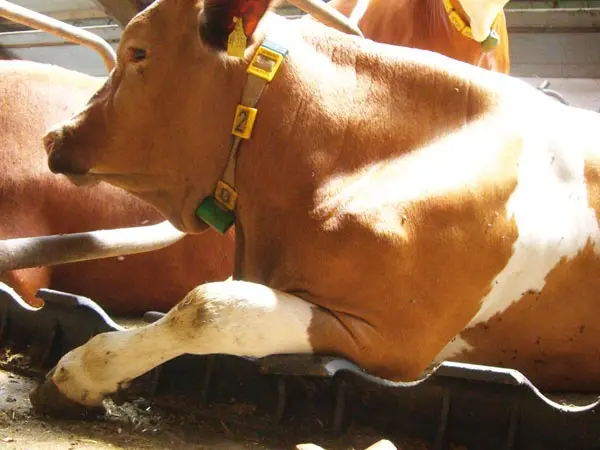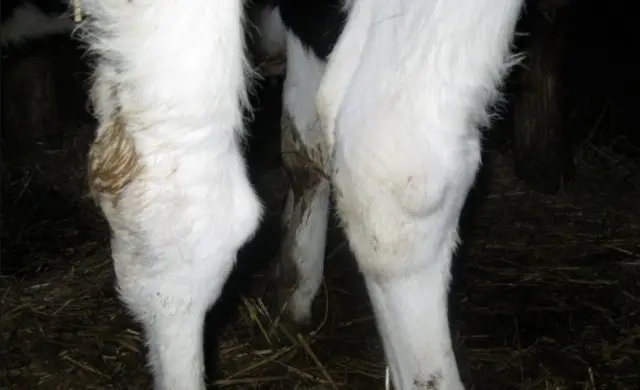Contents
Diseases of many animals are very similar to known human diseases. Between mammals there are coincidences in the structure of tissues, joints, muscles. The structure of the joints also has similarities, and therefore the pathologies are often the same. Arthritis in cattle is common and for various reasons. In order to effectively treat the disease, it is necessary to detect it in time in cattle and begin to act, but it is better to prevent the formation of painful processes in the joint.

What is bovine arthritis
Arthritis is inflammation of the joints in cattle. The animal limps at first barely noticeable, and with the course of the disease it gets stronger. The affected areas swell, and in a later stage there is severe lameness. The animal loses its productivity as well as weight. This is an acute inflammation of the joint, which occurs due to purulent infections.
This disease occurs in bulls, cows, calves, horses, pigs. In this case, age does not matter. In most cases, age is unimportant, after an injury, arthritis can develop even in a small calf.
Veterinarians distinguish not one, but a whole group of diseases that are united by the term “arthritis”. The nature of the disease can be dystrophic, mixed, and also inflammatory. Also, the disease is divided into primary, when the infection occurs directly in the joint, or secondary, when the infection enters the joint from neighboring tissues, as a result of abscesses, osteomyelitis.
Classification
The classification of the disease also determines its method of treatment, as well as the future prognosis for cattle. It is important to distinguish only the beginning process of inflammation of the joint from a severe pathology that can deprive the animal of a limb and greatly reduce the productivity of livestock. Cattle arthritis is divided into two types:
- purulent;
- aseptic.
A purulent variety occurs only after open wounds and dislocations on the joints. Often accompanied by fever and severely depressed state of the animal. At the same time, the aseptic variety also has acute and chronic forms, although the symptoms are similar to purulent arthritis.
As a result, growths, ecostoses, osteophytes can occur. With purulent arthritis, a rapid heartbeat is characteristic, the temperature rises.
Purulent arthritis affects the largest joints of the animal, for example, the elbow, hip, knee. Small joints are not subject to such destructive processes.
Causes of the disease
The main causes of the disease can be the following:
- injuries, sprains, bruises, torn ligaments;
- a strong load on the joints, due, for example, to excess weight;
- metabolic disease;
- malnutrition, which led to a lack of vitamins and minerals.
Also, the cause of arthritis in cattle is the natural aging process. Non-compliance with sanitary and hygienic standards for keeping cattle, both in private farms and in large barns, can also provoke the disease. Therefore, all standards of keeping prescribed by the sanitary service, as well as cleanliness in the barn, should be observed, and animals should be provided with sufficient exposure to fresh air. Then there is no need to fear for the health of the joints of calves, adult cows and bulls. Treatment for injuries should be rational and professional.

Symptoms of arthritis in cattle
The main symptoms of arthritis in cattle of any kind are:
- lethargy of the animal and refusal to feed (hence the loss in weight);
- lameness on the injured limb or its fixation in a certain position (forced position of the limb);
- joint swelling and severe pain;
- rapid heart rate;
- the affected area is hot and painful;
- the cow tries not to stand on the diseased limb;
- if you feel the diseased limb, pain is observed;
- bone outgrowth;
- if the arthritis is purulent, then fluid may be released from the joint cavity.
If you start purulent arthritis, then the animal from the herd must be culled, since the disease is not amenable to treatment at this stage in cattle. Therefore, it is important to start treatment at an early stage. With a through lesion, a clear liquid with small impurities of blood, called articular fluid, flows out of the wound.
Diagnostics
Purulent and aseptic arthritis are similar in symptoms. Modern diagnostic methods will help to more accurately determine the disease. But before proceeding to analyzes and instrumental diagnostics, the animal must be examined by a veterinarian.
The first of the instrumental methods is X-ray. Arthropuncture is often used, when fluid is taken from the joint for analysis and sent to the laboratory for analysis. They study the bacteriological composition and establish an accurate diagnosis. So you can determine rheumatism, tuberculosis, various tumors.
A specialist can evaluate the analysis indicators. For example, with capsular phlegnoma, the condition of the animal deteriorates sharply; when taking tests, the leukocyte counts are shifted to the left side. In a calm state, the cow keeps a limb in a half-bent form.
With paraarticular phlegnoma, the animal is depressed until the abscess opens. The cow often lies, sometimes completely refuses to feed.
The general condition of the animal is also assessed, which refuses to feed during the period of illness.
Therapies
The main method of treatment, which proved to be effective, is complex. First of all, it is important to provide peace to the joint and initially cold. Then there is heat treatment. Other methods of treatment should also be used:
- Wash the joint cavity with a solution of novocaine and antibiotics. To do this, one needle is inserted into two opposite diverticula. A medicinal solution is injected into one, and liquid comes out through the other.
- Opening the joint with removal of necrotic tissue, as well as applying a suction bandage.
- If the coffin joint is affected, a decision may be made to remove the toe.
- Circular novocaine blockade.
- Physiotherapeutic procedures.
- If the wound is small, then you can treat it with iodine.
- Use of a pressure bandage with tricillin and other antibiotics.
Vishnevsky’s ointment also helps. Boric acid is also used to treat wounds in cattle. The wound cavity after opening the joint is recommended to be treated with antiseptic powders.
Forecast
The prognosis for arthritis in cattle depends on the stage at which therapeutic measures began. The sooner the owner notices the problem and calls a specialist, the more favorable the prognosis will be.
In the chronic course of the disease, the prognosis is cautious, since it is most often difficult to completely save the damaged limb in cattle.

If the disease is advanced, then the animal has to be culled, regardless of its breeding value, and sent for slaughter. Therefore, it is so important not to start the disease, but to start timely treatment. Otherwise, complications may develop, such as:
- fistulas;
- deformation and shortening of the limb;
- ankylosis;
- arthrosis;
- dislocation.
If the dislocation in cattle is open, then it cannot be treated.
With capsular phlegnoma, the prognosis for the animal is doubtful, and in the presence of purulent osteoarthritis, it is often unfavorable.
Prevention of disease
Any disease is easier to prevent than to cure. Therefore, timely prevention of arthritis in cattle is very important. Subject to all preventive measures, the owner will be able to protect his cattle from any senile disease and complications, including cattle arthritis.
First of all, it is necessary to monitor the proper nutrition of cows and calves so that there is no lack of vitamins and minerals. It is important to properly organize the stay of livestock in the winter. If there are few sunny days, you can provide ultraviolet with artificial lamps that are mounted in the barn.
Regardless of where cattle are kept: on a private backyard or on a large farm, it is important to observe sanitary and hygienic standards.
Conclusion
Arthritis in cattle is a complex disease that affects the joints. When neglected, it leads to the loss of the animal and its culling. Arthritis in cattle is of primary and secondary nature, it can occur as an independent disease and as a complication after injury. Therefore, it is important to carry out primary surgical measures in case of injury to limbs by animals.









